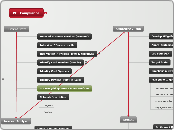If humans are motivated to prefer one direction within the pair, their intrinsic motor endures angst from the opposite direction
Negotiation Strategy
Mixed theories: The Harvard Concept
4. Find objective criteria
Encourage mutual acceptance of criteria - builds trust, both parties know the outcome is based on fair standards
Defend criteria-based solutions
Separate discussion from bargaining
Establish fair standards - objective benchmarks
3. Develop options
Generate multiple options - Brainstorm
Explore shared interests
Avoid a fixed-pie mentality
Expand the pie
2. Separate interests from positions
Create solutions that satisfy underlying interests
"Why" and "why not" questions - clarifies true motivations
Prioritize interests over rigid demands
Identify underlying needs
1. Separate people from problems
Distinguish relationship from the issue - negotiation as a problem-solving exercise not personal conflict
Open communication - active listening and acknowledging emotions
Focus on interests, not personalities
Maintain respect
Machiavelli's prince principles
Machiavelli's strategy does not extend outside of the competition negotiation
While love tears at every opportunity like a ribbon, fear of punishment never wanes.
People are ungrateful, inconsistent, deceiving, cowardly in time of danger and greedy for profit
Being both loved and feared is desirable - if they cannot be combined fear is preferable
Advantageous to be able to put on different faces
Those succeed who break their promise at the right moment
Short-term planning, conflict potential incredibly high
The principles he mentioned can only be recommended in a limited way
General guidelines
Strategic considerations
Components which set the framework for the entire strategy
The personality
The personal ethic
The objective setting
3. While organizing theories and choosing appropriate one we put them on a graph. This can be used while assessing the situation and keep track of turbulent negotiations
2. A summary of different negotiation theories/concepts will give a good overview of the main approaches
1. Principles for the choice of strategy provide orientation before starting the negotiation
Guidelines consist of principle considerations and the situational matrix that serves as a matrix for strategic choices
Master Negotiator strategy depends on several factors that are different for every negotiation situation
There's no one formula/strategy which would always work
Chosen strategy does not predetermine any concrete actions
The Master Strategy
Co-ordination negotiations
Negotiation
May serve as a training ground
Allows participants to save time and energy
Resource-conserving approach for situations with minor conflicts
Relationship negotiations
Empathetic communication, emotional balance
Best if ongoing positive rapport is crucial
Avoids tactical manipulations, focuses instead on trust-building
Relationship over specific negotiation outcome
Partnership negotiations
Avoids aggressive tactics
Interests of the partners wishes and ideas
Creativity and communication focused strategy
Worth time to explore the interests of your negotiation partner
Aims to balance conflict resolution with long-term relationship building
Competition negotiations
Structured tactics like detailed bluffs and counter-arguments
Techniques like argumentation, stress tactics, "thick skin" approach
Little to no emphasis on relationship building, energy is directed towards winning outcomes
Focuses on short-term and high conflict objectives
The principles of Robert McNamara
Never say never
Rationality will not save us
Empathise with your enemy
President Nixon principles
Never give up inulaterally what could be used as a bargaining chip. Make sure your adversaries give something for everything they get.
Always leave your adversary a face-saving line of retreat
Never seek publicity that would destroy the ability to get results
Never be belligerent but always be firm
Always be prepared to negotiate, but never negotiate without being prepared
Main strategies
Politically inspired strategies
Useful in case of negotiaions with diverse interests, because it balances assertiveness with adaptability
Sees counterparts interests as a whole while safeguarding one's own
Derived from political negotiation tactics, it values calculated flexibility and empathy
Tactical and technique-oriented strategies
Less focus on relations-building which is disadvantage in case of repeated interactions
Good in high-stakes, short-term or competitive cases
Emphasizes precise and planned tactics (argumentation techniques, stress application)
Creativity and option-focused strategies
Adapts to changing dynamics - flexibility which is helpful in case of discussions stalling or reaching a deadlock
Builds on trust - creativity can flow if both parties are open to share and explore ideas
Balances imaginativ ideas with practicality
Avoids zero-sum thinking, instead tries to expand the pie
Outside the box solutions - reframes challenges and looks for unconventional win-win outcomes
Encourages brainstorming while utilizing creative thinking methods like mind mapping to explore many options
Communication focused strategies
Knows when to end - if other part is unyielding, notices the"minus" situation and avoids wasting resources
Plus-situation where counterpart says "yes" to your offer without much deliberation is basically luck
Employs active listening - clarifying questions
Applying I-messages instead of You-messages expressing needs without defensiveness
Gordon 3 different approaches to the communication partner
Method 3 - approach without losers
Methof 2 - the opposite. needs and interests are suppressed. Reversed premises.
Method 1 - win/lose method one's position is recklessly presented and pushed through
Prerquisite is the intention to find a mutually beneficial solution and showing real interest in the needs of the counterpart
Efficient communication, appropriate selection of verbal and body language
Personality type oriented strategies
Fritz Riemann 4 basic forms of angst in his personality theory
Those fears have to be discerned to be able to use them
Its opposite longing for change and risk
The longing for duration and security
Its opposite motivation for self-sacrifice and affiliation
Longing for self-preservation
Kennedy theory with "red" and "blue" negotiation styles
Influencing with empathy
Analyses personal traits
Tailors to individual motivations and intentions
Relationship focused strategies
Staying in touch and reinforcing agreements keeps strong relationship
Works only if both sides are committed to a win-win outcome
May not suit short-term and competitive scenarios
Prioritizes mutual benefit and open communication to foster long-term relationships
Builds a foundation of trust and fairness
Assign enough time to build up a win-win mentality before starting to bargain









